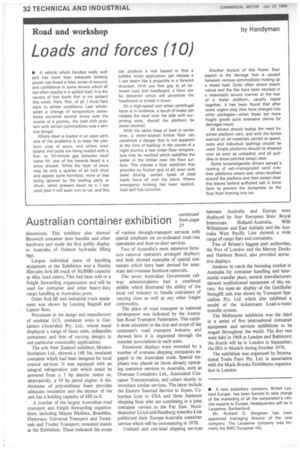Road and workshop by Handyman
Page 34

If you've noticed an error in this article please click here to report it so we can fix it.
Loads and forces (10)
• A vehicle which handles really well and has more than adequate braking power can breed a false sense of security and confidence in some drivers which all too often results in a spilled load. It is the causes of lost loads that is my subject this week. Here, first, of all, I must hark back to winter conditions. Last winter, when a change of temperature sometimes occurred several times over the course of a journey, the load shift problem with certain commodities was a serious danger.
Where steel is loaded in an open yard, one of the problems is to keep the platform clear of snow, and where steel beams and joists are being loaded with a fiveto 10-minute gap between each crane lift, one of the hazards faced is a snow shower. While the layer of snow may be only a quarter of an inch thick and appear quite harmless, more or less being ignored by the loading party or driver, when pressed down by a 1-ton steel joist it will soon turn to ice, and this can produce a real hazard in that a sudden brake application can release a 1-ton beam like a projectile in a forward direction. With any free gap at all between load and headboard, a blow can be delivered which will penetrate the headboard or smash it down.
On a high-speed turn when centrifugal force is in evidence, a touch of brake can release the steel over the side with surprising ease, should the platform be snow-covered.
With the same class of load in winter time, a water-soaked timber floor can constitute a danger that is not apparent at the time of loading: in the course of a night journey a low under-floor temperature may be reached which solidifies the water in the timber near the floor surface. This creates a floor condition that provides no friction grip at all; even with staid driving, certain types of steel loads move all over the place. Where emergency braking has been applied, load spill has occurred. Another feature of this frozen floor aspect is the damage that is caused between various commodities making up a mixed load. Quite often where steam valves and the like have been stacked in a reasonably secure manner at the rear of a trailer platform, usually roped together, it has been found that after some urgent stop they have charged into other packages—when these are more fragile goods quite extensive claims for damages result.
All drivers should realize the need for winter platform care, and with the forces exerted on all materials carried at speed, extra and individual lashings should be used. Empty platforms should be sheeted over as soon as unloaded, and all puddles or snow patches swept clear.
Some knowledgeable drivers spread a coating of salt-impregnated sand over their platforms where wet: when brushed around the platform and then swept clear this leaves behind sufficient salt in brine form to prevent the dampness on the floor from forming into ice.
















































































































